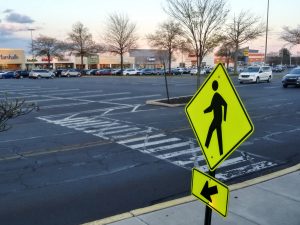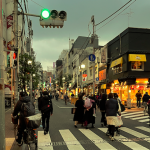New Jersey Future Blog
If You Pave It, They Will Park
April 25th, 2022 by Tim Evans

Would you walk here? Parking lots not only push individual buildings farther apart, but they make the experience of walking between buildings unpleasant and unsafe. Photo Credit: Tim Evans
Driving and parking reinforce each other. The provision of parking at every destination encourages people to drive, and the more people drive, the more parking spaces property owners think they need to provide. Fortunately, New Jersey’s older, mixed-use centers show that the pattern can also work in reverse.
New Jersey’s transportation system—and that of the entire United State—is oriented toward the private automobile (now including pickup trucks and sport-utility vehicles), and has been since the 1950s, when construction began on the Interstate Highway System, kicking off an era of massive federal spending on roads. For almost three-quarters of a century at this point, new development has been built under the default assumption that residents, customers, and employees would be arriving and departing by car, and roads have been designed with the primary goal of facilitating easy car travel among destinations.
Part of a car-oriented system is the space required to store all these vehicles when not in use—that is, parking. Driving and parking reinforce each other. The more people drive, the more developers and local planning officials think every new project needs to be surrounded by parking. And the more parking is available at every destination, the more people will tend to drive. Parking lots not only push individual buildings farther apart, but they make the experience of walking between buildings unpleasant and unsafe, further reinforcing the impulse to drive, even between destinations that are relatively close together.
But it wasn’t always like this, nor does it need to remain this way. New Jersey is full of older, walkable, mixed-use centers—not just cities but plenty of pre-1950s suburban downtowns—that were built before the private automobile came to dominate the transportation landscape. Their development patterns are oriented more toward walking and public transportation than toward driving everywhere. As such, they offer a blueprint for how to build in a way that facilitates access by means other than driving, a practice that New Jersey needs to re-learn if it hopes to provide more of the kinds of live-work-play-shop environments that today’s young adults are looking for.
An important part of the equation when designing development for access by means other than just cars is to not require so much parking. Cities around the country are beginning to experiment with dialing back their parking requirements, so that new developments are allowed to look more like the mixed-use, walkable centers that were the norm before governments started pouring money into expansion of the road network. New Jersey should embrace the reexamination of parking requirements, start reclaiming some of its land from vehicles, and put it to better use in improving the quality of life of its residents.
Download the full report.
Related Posts
Tags: developers, Development, Driving, Parking, Pedestrian, Transportation, walkability
















